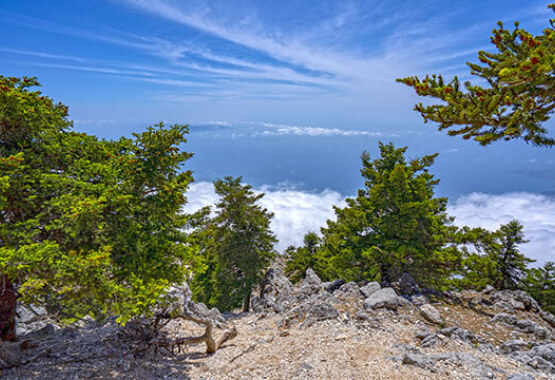
LESVOS
Intense volcanic eruptions resulted in the flow of pyroclastic material and ash which eventually covered the whole of the area where the Petrified Forest now lies. The following nature’s activity led to a molecule-to-molecule substitution of the organic matter of the trees; and it was so perfect a substitution that not only the trunks but also roots, fruit, leaves and seeds, well protected within volcanic rocks, are astoundingly preserved. The huge environmental, geological and paleontological value of the Petrified Forest earned a national recognition when it was declared a Natural Monument by the Greek State, and an international one, when it became a founding member of the European Geoparks Network and a member of the Global Geoparks Network.
There are four fossil bearing sites turned into parks to visit in the area: the one in Sigri, adjacent to the world singular Natural History Museum, the Park at the islet of Nisopi, the Plaka Park, and the Park of the Petrified Forest. A network of paths and walks interconnects the parks and the places of interest (volcanic concentrations etc) providing you with the enviable chance to discover all of the wonders of the site. Two well-know as “the paths of lava” walks start at Kalloni to run across the Geopark and offer visitors to the western part of Lesvos an experience to remember.
The Petrified Forest of Lesvos
A Significant Natural Monument
Petrified trunks, scattered over an area of 150 square kilometres surrounded by the settlements of Sigri, Eressos and Antissa in western Lesvos, bear witness to an impressive “cosmogony” that marked the geological history of the basin of the Aegean Sea over 20 million years ago.
Intense volcanic eruptions resulted in the flow of pyroclastic material and ash which eventually covered the whole of the area where the Petrified Forest now lies. The following nature’s activity led to a molecule-to-molecule substitution of the organic matter of the trees; and it was so perfect a substitution that not only the trunks but also roots, fruit, leaves and seeds, well protected within volcanic rocks, are astoundingly preserved. The huge environmental, geological and paleontological value of the Petrified Forest earned a national recognition when it was declared a Natural Monument by the Greek State, and an international one, when it became a founding member of the European Geoparks Network and a member of the Global Geoparks Network.
Walking through the “forest of silence”
The rarity and uniqueness of the site meet no fair description by words. With hundreds of standing and fallen red, yellow, green and black trunks of conifers and other trees, with gigantic intact root systems, with the thickest standing petrified tree in the world (circumference of 13,7m) and with the tallest one in Europe (7,02m), the Petrified Forest of Lesvos is not only the second largest of its kind in the world, but also the ideal proof of the almighty magnificence of Nature.There are four fossil bearing sites turned into parks to visit in the area: the one in Sigri, adjacent to the world singular Natural History Museum, the Park at the islet of Nisopi, the Plaka Park, and the Park of the Petrified Forest. A network of paths and walks interconnects the parks and the places of interest (volcanic concentrations etc) providing you with the enviable chance to discover all of the wonders of the site. Two well-know as “the paths of lava” walks start at Kalloni to run across the Geopark and offer visitors to the western part of Lesvos an experience to remember.




